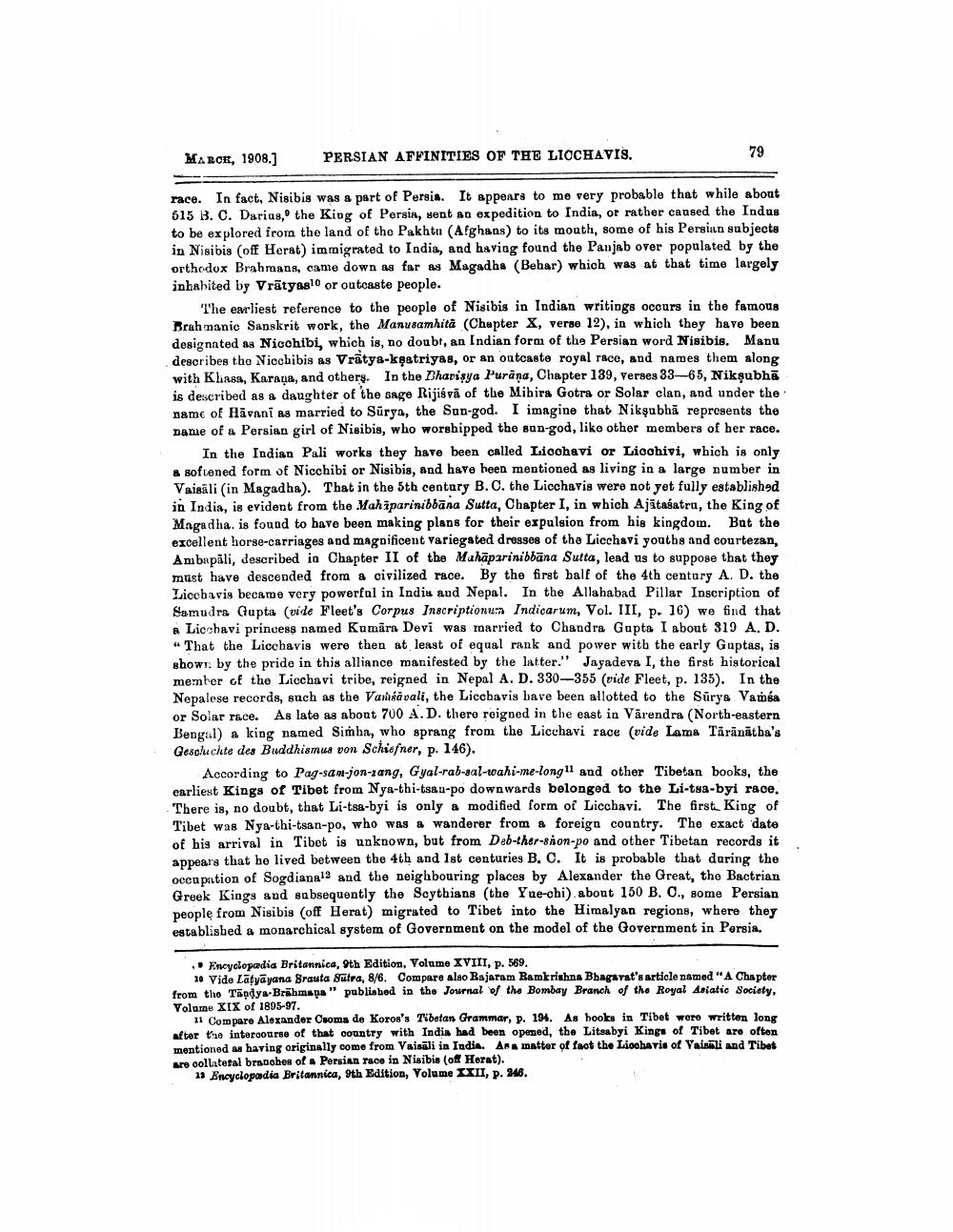________________
MARCE, 1908.]
PERSIAN AFFINITIES OF THE LIOCHAVIS,
79
race. In fact, Nisibis was a part of Persia. It appears to me very probable that while about 515 B. C. Darias, the King of Persia, sent an expedition to India, or rather caused the Indus to be explored from the land of the Pakhtu (Afghans) to its month, some of his Persian subjects in Nisibis (off Herat) immigrated to India, and having found the Panjab over populated by the orthodox Brahmans, came down as far as Magadha (Bebar) which was at that time largely inhabited by Vrātyaslo or outcaste people.
"The earliest reference to the people of Nisibis in Indian writings occurs in the famous Brahmanic Sanskrit work, the Manusamhita (Chapter X, verse 12), in which they have been designated as Nicchibi, which is, no doubt, an Indian form of the Persian word Nisibis. Manu describes the Niochibis as Vrātya-kşatriyas, or an outcaste royal race, and names them along with Khasa, Karana, and others. In the Bhavisya Purana, Chapter 139, verses 33-65, Niksubhā is described as a daughter of the sage Rijis vă of the Mihira Gotra or Solar clan, and under the name of Hāvani as married to Surya, the Sun-god. I imagine that Niksubhā represents the Dane of a Persian girl of Nisibis, who worshipped the san-god, like other members of her race.
In the Indian Pali works they have been called Lioohavi or Lioohivi, which is only & softened form of Niochibi or Nisibis, and have heen mentioned as living in a large number in Vaisüli (in Magadha). That in the 5th century B.C. the Liochavis were not yet fully established in India, is evident from the Mahiparinibbāna Sutta, Chapter I, in which Ajūtasatru, the King of Magadha, is found to have been making plans for their expulsion from his kingdom. But the excellent horse-carriages and magnificent Variegated dresses of the Licchavi youths and courtezan, Ambapali, described in Chapter II of the Mahāparinibbāna Sutta, lead us to suppose that they must have descended from a civilized race. By the first half of the 4th century A. D. the Licobavis became very powerful in India and Nepal. In the Allahabad Pillar Inscription of Samudra Gupta (uide Fleet's Corpus Inscriptionum Indicarum, Vol. III, p. 16) we find that a Liechavi princess named Kumāra Devi was married to Chandra Gupta I about 319 A. D. "That the Liochavis were then at least of equal rank and power with the early Guptas, is shown by the pride in this alliance manifested by the latter." Jayadeva I, the first historical member of the Liechavi tribe, reigned in Nepal A. D. 330-355 (vide Fleet, p. 135). In the Nepalese records, such as the Vaihkavali, the Licchavis bave been allotted to the Sūrys Vamsa or Solar race. As late as about 700 A.D. thero reigned in the east in Värendra (North-eastern Bengal) a king named Simha, who sprang from the Licchavi race (vide Lama Tärinätba's Gescluchte des Buddhismus von Schiefner, p. 146).
According to Pag-saat-jon-zang, Gyal-rab-sal-wahi-me-long 11 and other Tibetan books, the earliest Kings of Tibet from Nya-thi-tsa u-po downwards belonged to the Li-tsa-byi race. There is, no doubt, that Li-tsa-byi is only a modified form of Licchavi. The first King of Tibet was Nya-thi-tsan-po, who was a wanderer from a foreign country. The exact date of his arrival in Tibot is unknown, but from Deb-ther-hon-po and other Tibetan records it appears that he lived between the 4th and 1st centuries B. C. It is probable that during the occupation of Sogdiana!and the neighbouring places by Alexander the Great, the Bactrian Greek Kings and subsequently the Scythians (the Yue-chi) about 150 B. O., some Persian people from Nisibis (off Herat) migrated to Tibet into the Himalyan regions, where they established a monarchical system of Government on the model of the Government in Persia.
.. Encyclopædia Britannica, 9th Edition, Volume XVIII, p. 569.
10 Vide Latyāyana Srauta Sutra, 8/6. Compare also Rajaram Ramkrishna Bhagavat's article named "A Chapter from the Tāodya-Brühmapa " published in the Journal of the Bombay Branch of the Royal Asiatic Society, Yolame XIX of 1895-97. 11 Compare Alexander Cwoma de Koros's Tibetan Grammar, P. 194. As hooks in Tibet were written long
ntercourse of that country with India had been opened, the Litsabyi Kings of Tibet are often mentioned as having originally come from Vaisali in India. Ara matter of fact the Lioohavis of Yaisali and Tibet are collateral branches of a Persian race in Nisible (of Horat).
13 Encyclopaedia Britannica, 9th Edition, Volume XXII, p. 346.




